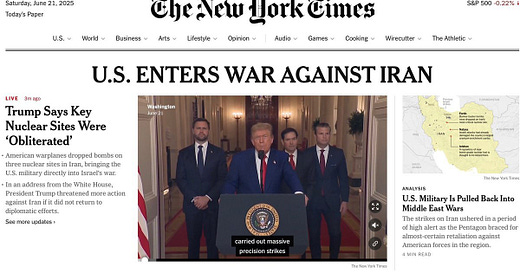Trump Just Went to War. Quietly. Illegally. Desperately. And he may have just guaranteed Iran gets the bomb.
How a failing president unleashed airstrikes to distract from domestic collapse—and what Iran might do next.
On June 22, 2025, in the middle of the night, a fleet of B-2 stealth bombers left Missouri and dropped bunker-busting bombs on three nuclear sites in Iran.
There was no press conference. No congressional authorization. No international coalition. Just a social media post from a legally embattled president who’s losing grip on power, shouting into the void: “The hits were hard and accurate.”
What followed wasn't just an act of war—it was the most violent single action of Donald Trump’s two terms and one of the most dangerous unilateral escalations in modern U.S. foreign policy. And it happened as Trump faces a tidal wave of domestic crisis: legal indictments, tens of millions marching in protest, the destruction of America’s international reputation, and a rapidly shrinking economy.
A man who once ran on “no more endless wars” just stumbled us into one.
Trump’s Real Motivation? Look at the Polls. The Protests. The Panic.
With the U.S. economy slipping into negative GDP growth, inflation back on the rise, and millions in cities from New York to Phoenix protesting his authoritarian lurch, Trump needed a distraction. Badly.
So he bombed Iran.
Let’s be clear: this wasn’t about national security. The intelligence behind the strikes—that Iran was "weeks away" from building a nuclear bomb—hasn’t been independently verified. U.S. spy agencies reportedly disagreed with the assessment. The president released no evidence to the public. This wasn’t a military necessity. It was a political Hail Mary.
A strongman under siege needed a show of strength. A distraction from legal, popularity, trade, human rights, and financial disasters at home. A made-for-TV war.
What Did Trump Actually Hit?
Fordow Nuclear Site: Deep underground. Suffered "significant" structural damage, per the IAEA.
Natanz: The bombings sent shockwaves through one of Iran’s most advanced centrifuge sites.
Isfahan: Notably, this strike failed to destroy Iran’s underground uranium stockpile. Experts now say Iran’s cache of 60% enriched uranium—enough for a bomb—likely survived.
“A big boom and a lot of dust,” said Rep. Jim Himes, House Intelligence Committee ranking member. “Anyone claiming total destruction is full of it.”
According to Middlebury Institute weapons expert Jeffrey Lewis, “If this is all there is, the entire uranium stockpile is untouched. That’s a strategic failure.
What Iran Might Do Next
1. Military Retaliation
Iran has promised a “proportionate response,” and the IGRC is no military slouch.
Targets may include U.S. military bases in Iraq, Syria, Kuwait, Bahrain, and Qatar, where 40,000 American troops are stationed.
Missiles already struck Tel Aviv, injuring dozens.
The IRGC may use asymmetric warfare tactics through its remaining proxy networks.
2. Strait of Hormuz Shutdown
Iran could block the world’s most important oil shipping lane.
20 million barrels of oil pass through daily.
This move would spike global prices, collapse markets, and gut Trump’s fragile economic façade.
3. Cyber and Terror Attacks
Iranian-linked cyber teams may retaliate with infrastructure hacks.
The IRGC has a global network capable of launching low-cost, high-chaos attacks anywhere from Bahrain to Brooklyn.
4. A Nuclear Sprint
Iranian experts warn the strikes may backfire completely.
“This may have convinced Iran to go for the bomb,” said Trita Parsi of the Quincy Institute.
Likely outcomes:
Withdrawal from the Nuclear Non-Proliferation Treaty.
Reconstitution of nuclear infrastructure—faster, deeper, more hidden.
The Homefront: Protests, Panic, and Presidential Overreach
Trump bypassed Congress. Again. There was no war declaration. No emergency resolution. Just bombs.
Even Vice President JD Vance tried to gaslight the nation: “We’re not at war,” he said, on national television.
Meanwhile:
Mass protests have erupted in major cities.
Congressional Democrats and some GOP senators are calling for emergency war powers reviews.
Oil prices jumped 12% in 48 hours.
Markets plunged, with the Dow shedding 700 points by Monday morning.
Americans are asking: What did we just do? And the world is asking: Can we ever trust the U.S. again?
The World Is Watching—and Pulling Away
At the recent G7 summit in Alberta, Trump was already isolated. Mark Carney, Emmanuel Macron, and Keir Starmer openly criticized Trump’s “reckless posturing.” Whispers of removing the U.S. from the G7 are now echoing louder.
Europe’s diplomatic talks with Iran were in progress—until Trump bombed the table.
The UN is alarmed at the scale and legality of the strikes.
China and Russia now have leverage, ready to blame Trump for any escalation that disrupts global markets.
This isn’t American strength. It’s American chaos.
What’s the Endgame, Donald?
Regime change? Retaliation? Negotiation?
Trump himself can’t decide. On Truth Social, he posted:
“Why wouldn’t there be a Regime change???”
Classic Trump: blow something up, tweet nonsense, hope it sticks.
But there’s a brutal truth here. This president—already dismantling democracy at home—is now igniting the fuse of a war that could:
Collapse global markets,
Spur nuclear proliferation,
And hand Iran every justification it needs to pursue a bomb.
This Wasn’t Just a War Crime. It Was a Campaign Strategy.
Donald Trump is a man who believes institutions—law, courts, media, even the military—exist to serve his ego. And now, he’s using the U.S. military as a political tool in a personal crisis.
Remember what former Trump adviser John Kelly once said:
“Trump believes war makes presidents popular.”
I guess we’ll see.










I just hope that this will help the reluctant republicans move towards removing Trump, and Vance by association as quickly as possible. Even if that does leave us with a whole new basket of problems with whatever successor.
“DON’T RAISE OIL PRICES” is the cry of a man-baby who knows he’s already lost.